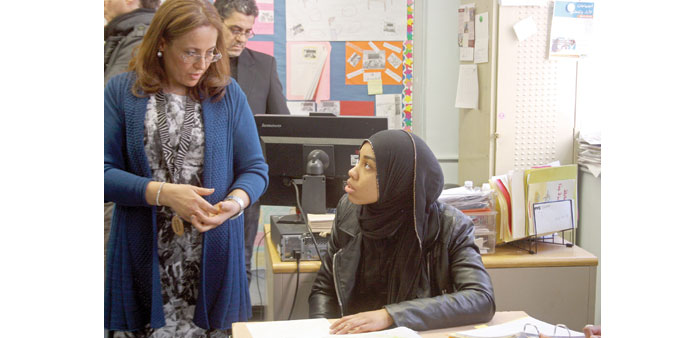A teacher, left, chats to a female student in a classroom at Khalil Gibran International Academy in New York City.
By Christina Horsten
The two 15-year-old girls in headscarves were talking about school and giggling. They said they especially liked math and the hamburgers served in the cafeteria. And teen heartthrob Justin Bieber, of course, along with American movies — preferably with Arabic subtitles — and US President Barack Obama.
A year ago Yamama Hassan and Entesar Yahya fled to the United States with their families from war-torn Yemen. Now they take the subway in the morning from the heavily immigrant Flatbush neighbourhood to the centre of the New York City borough of Brooklyn, where they attend the Khalil Gibran International Academy (KGIA) — the first English-Arabic public school in the country, the school says.
“We like it better here. There are more opportunities,” said Hassan in unaccented English.
The girls said their fathers had also learned a little English, but that their mothers hadn’t yet.
“We’re happier here,” said Yahya. “It’s safer.”
New York City epitomises a “melting pot” of diverse races and nationalities. According to the New York City Department of City Planning, 37.2 per cent of the city’s more than 8 million inhabitants are foreign-born, and in some neighbourhoods more than two-thirds are.
With foreign-born mothers accounting for 51 per cent of all births, approximately six in 10 New Yorkers are either immigrants or the children of immigrants, and 49 per cent of the population speaks a language other than English at home.
Harmony amid the diversity is hardly perfect, of course, and the number of hate crimes, though comparatively small, has recently risen somewhat — particularly against Muslims and Jews. The New York City Police Department reported 127 such crimes in the first half of this year, an increase of 9 per cent over the same period a year ago.
The KGIA, founded in 2007, aims to foster better understanding of different cultures. Over the past four years, the city has spent more than 3 million dollars in completely renovating the former hospital building.
“It’s a mixture and we’re proud of it,” said Principal Winston Hamann, speaking of a school staff whose diverse backgrounds match those of the student body.
Hamann himself comes from Colombia, and the assistant principal from Greece. The Arabic teachers hail from countries including Algeria and Morroco, and the administrative office is headed by a Haitian woman. While the staff isn’t required to know Arabic, knowledge of both Arabic and English is mandatory for students.
The school’s dress code isn’t too prescriptive. Students can wear shorts, a headscarf or full body veil. Many have to work after school to help feed their families, a school counsellor said.
The KGIA’s lead community partner is the non-profit, secular Arab-American Family Support Center (AAFSC), New York City’s first and largest Arabic-speaking social service agency. The AAFSC has an on-site “school coordinator” to ensure that all students and their families have access to a wide range of services.
Headquartered in Brooklyn, home to the highest number of New York City’s recent Arab immigrants, the AAFSC serves nearly 6,000 low-income people each year through programmes including counselling, legal services, healthcare, anti-violence, and English as a second language. Many of the immigrants who seek its help are illiterate, and most speak no English in the beginning, like Hussein from Egypt.
A lottery winner of a Green Card allowing him to live and work in the United States permanently, Hussein had stopped by the AAFSC in a red hoodie.
“My four kids have learned English faster, I’m behind,” he said. “But I found work as a driver and I like it here. I want to stay forever.”
Yolanda, a Yemeni who lives in the New York City borough of the Bronx, learned how to read and write at the AAFSC. She said her son was a barber and that he used to have to accompany her everywhere. But now she can travel by subway on her own.
“The support centres work better in the United States than in Europe,” remarked Lena Alhusseini, the AAFSC’s executive director. “We work more towards building a community. But we’re also witnessing a rise in hate crimes.”
She said she had recently helped the family of a 15-year-old boy told by the driver of a public bus to get off because he spoke Arabic.
“The family wouldn’t have contacted the police by themselves,” Alhusseini said. —DPA

